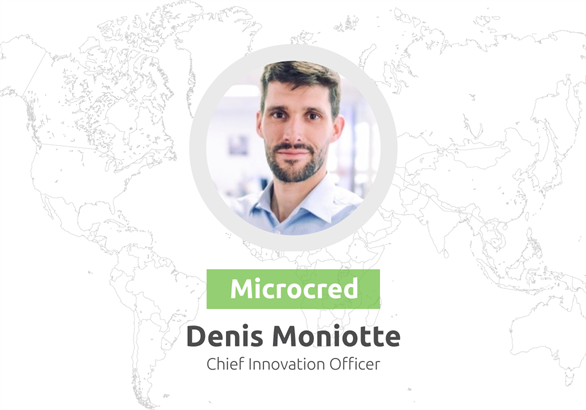We are pleased to introduce Mr. Denis Moniotte, Chief Innovation Officer at Microcred. We are discussing with Denis the microfinance business and how alternative delivery channels can elevate the operations of microfinance institutions. Microcred has leading financial services and products that improve clients’ lives while working on financial inclusion in Africa and China. The company offers financial services to emerging client segments particularly the unbanked with a focus on micro & SME loans. Microcred operates in Madagascar, Senegal, Nigeria, Ivory Coast, Mali, Zimbabwe, Burkina Faso, Tunisia and China. Founded in 2005, the group is one of the few global financial institutions that has been able to deploy cost-effective model to address the issue of Micro & SME financing globally in an innovative way.
Hi Denis, we are glad to have you as a guest of the SG Insider. Could you please tell us more about Microcred and how your company’s business has evolved over the years?
Microcred’s main business operations are concentrated in Africa, a market with a strong tradition in microfinance. If we are looking at the company’s business model, we can certainly say that it is successful. We have proved that we can replicate profitable operations across geographies. Our challenges really come from the ability to scale. After so many years of operation we were still facing the challenge to find a way to expand our customer base substantially in all the countries we are operating in. When you look at the amount of energy spent to serve profitability, not growing the number of your clients fast enough is kind of an issue because it is such an untapped market. You cannot just say that if I am profitable but not being able to scale is fine. If we don’t achieve this scalability ourselves, we are going to be disrupted by someone who will come and take our business with more scalable business model.
Our business is extremely time consuming and has a lot of manual work, hence, it is hard to scale. It is very difficult to cross-sell, upsell or diversify and that is the biggest challenge we had to solve. We realized that we need to activate a business model which is much more scalable, doesn’t have many manual interventions, and needs to disburse loans in five minutes by automated decision making.
Apart from the scalability, are there any other challenges your company was facing?
We were in a situation in which we were serving the microfinance business but we had no delivery channels implemented, only a core banking system. We had to interact with the branches by posting transactions in the branch only. The system had limited functionalities and needed to make sure that the interest was calculated well, loans were tracked properly and the transaction was secured. We had no integration capability, no business rules engine, no data analytics, no automated AML or full loan origination. Hence, all these caused more challenges such as long time to market and high cost of maintenance. We realized that we cannot improve our efficiency or deploy more channel offerings. So, we decided to start an IT selection program internally to change our IT landscape and help us achieve these goals. Thus, we looked at different companies and selected Software Group.
Tell us more about your partnership with Software Group and your mutual projects.
We started our initial relationship with Software Group in 2013, when we got to know one of your integration products – UT Route. It was exactly what we were looking for in terms of technology. The more we were looking at the things we wanted to have, the more we were convinced that Software Group is the right vendor for us and the potential of the software was very important.
Currently what we use from Software Group is more like a toolbox – it allows us to use the tools to provide improved customer experience to our clients.
The scope of the project currently includes Agency Banking, ATM integration, Mobile Money Integration, SMS, Loan office mobile apps and Web front end.
Software Group has a deep understanding and experience in our industry which is very specific, inclusive finance, particularly in Africa. We managed to build a strong partnership, have a mutual commitment and do the best with our solutions.
How has your business changed after embarking on this journey? What were the benefits for your organization and customers?
We strongly believe that to open new doors to the business, you need to change your IT operations. Initially, it can have some challenges but it has significant impact. For our operations and business, it improved the quality of our services. The clients repay their loans or open their accounts from agent’ networks, commercial officers can bring their portfolio to the field. We are on our way to get the scalability we want. This process has already been started and currently, we are progressing to build new business models and extend the capabilities critical for our operations. We should move from a business model where we have a few customers and a high margin on each of them (and few means globally half a million) to a business where we have minimum 1 million per country and smaller margins.
What we deliver together with Software Group are basically two things – transactions and time efficiency. The first major benefit is the proximity of transactions, you can transact whenever you want. After the implementation of the solutions from Software Group Microcred was able to multiply its points of interactions with customers by 15 times. That is a big difference for our clients.
The second benefit is the time it now takes to onboard new clients. The procedure for opening an account used to be a very long and painful process where you have to physically come to the branch multiple times and bring different sets of documents. Now we turned all that into a five-minute experience. You don’t have to bring documents and you can do it for five minutes on the street. This helped us improve our first-time customers experience significantly. Currently, Microcred is covering 8 countries in Africa and Asia and the company plans to expand its business to 15 countries by 2020. By the same time the company is planning to increase its customer base from 500 000 to over 6 million customers.






